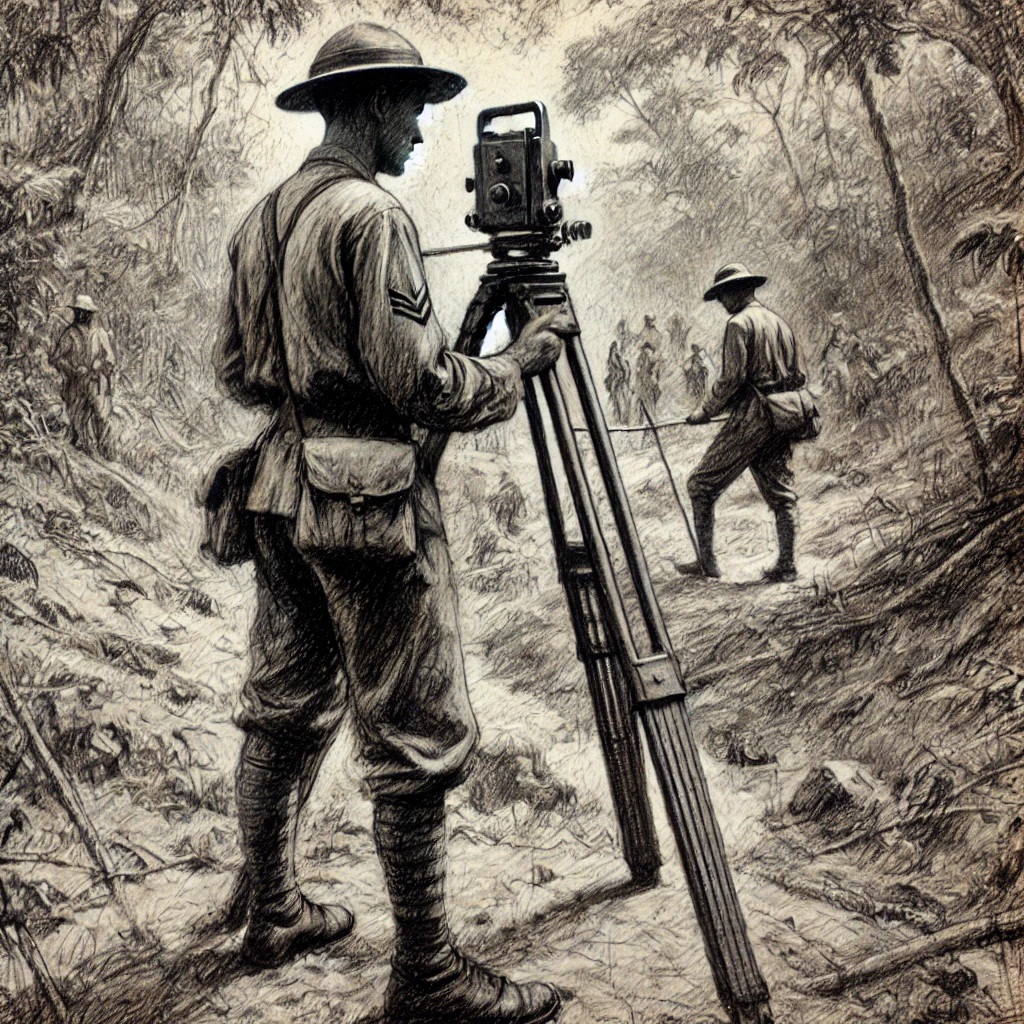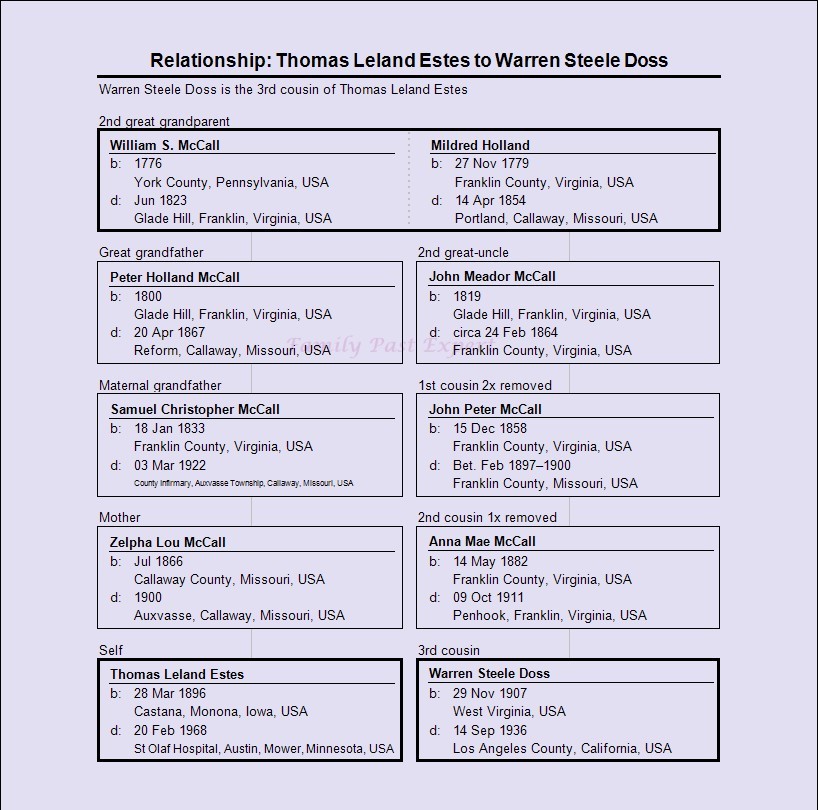Warren Steele Doss, a “cousin” from the McCall side of the family helped with the Nicaraguan Canal. Yeah, I’d never heard of it either.
It is so easy to get distracted as I gather the descendants of my ancestors for my books. This week, I met Warren Steele Doss. His military transport records made me pause. He was in the army between the first and second world wars and was being transported to Panama and from there to Corinto, Chinandega, Nicaragua. I wondered why, so I did some investigation.
Warren Steele Doss
Warren Steele Doss was a 21-year-old private when he first showed up in military records. His mother, Anna Mae McCall died before Warren was four-years-old, so he was raised in Penhook, Franklin, Virginia, by his dad and step-mother. An infant sister died two months before his mom and a toddler brother died a day before his mom. 1911 was not a good year for the Doss family. By 1929, Warren was a young adult and in the army.
The records show that Private Doss, who was born 29 November 1907 in West Virginia, left Schuyler, New York, on 13 January 1929, on board the Chateau Thierry bound for the Panama Canal Department. He then left Panama on 06 September 1929 onboard the ship Grant bound for Corinto, Nicaragua, and was there until the ship St. Mihiel landed back in Panama in very late 1930. He landed back in Brooklyn, New York, on 21 January 1931. 1 2 3 4
The Panama Canal
In early 1929, when Warren Steele Doss arrived at the Panama Canal Department, the canal was operating smoothly under U.S. administration. Since its opening on 15 August 1914, the canal had been a vital conduit for naval movements and international maritime trade, significantly reducing travel time between the Atlantic and Pacific Oceans. By 1929, the canal had been in operation for 15 years, and during the fiscal year 1929, it set peak records for the aggregate tonnage of vessels transiting, tolls collected, and tons of cargo carried. 6,413 commercial ocean-going transits passed through. While there were occasional maintenance challenges and geopolitical tensions, there were no major operational problems reported in that year.5 6
Nicaragua?
A 1930 article in the Norfolk, Virginia, Ledger-Star discussed what Warren was doing in Nicaragua. It explained that the army engineers were making the preliminary survey for a proposed Nicaraguan canal, “a more gigantic undertaking than was the Panama Canal.” The article listed Pvt. Warren S. Doss of Penhook, as one of the four Virginia men involved in the operation. 7

In the early 1900s, the United States had had two options: build a canal across Nicaragua, or, through Panama. The US Senate voted for the Panama option. It was a relatively easy choice – the route was shorter and, unlike Nicaragua, there wasn’t a string of active volcanoes in the way to contend with. There were plenty of worldwide politics involved, but the Panama Canal had been built. The Nicaragua route, however, was not completely forgotten.8
In the late 1920s, US interest in the Nicaragua Canal resurged as capacity concerns over the Panama Canal incited the consideration of a second interoceanic waterway. On 02 March 1929, the Senate and House of Representatives jointly passed a resolution authorizing the appointment of an Interoceanic Canal Board to study all routes for the construction of a second isthmian canal. Two days later the necessary funds were appropriated. A provisional battalion of U. S. Army Engineers under the command of Lieutenant Colonel Dan I. Sultan conducted the survey of the Nicaraguan route from August, 1929, to July, 1931.9
The survey work was described as important but not necessarily glamorous. The men had to work “under the blistering sun, invading the saurian jungles, invading the saurian jungles,” and “braving the pestilential swamps.” Conditions in Nicaragua were not the same as in the United States, with ox-carts sometimes being the only means of transportation. The engineers had to endure “torrid” heat, “reckon with monkeys, alligators, wild beasts,” “pestiferous and venomous insects,” “torrential rains” and “lonesomeness.”
On the positive side, the army men had a chance to fish with The Lake of Nicaragua being a fisherman’s paradise.
Built it (or not)
The report of the 1929-1931 expedition, in which Warren Steele Doss was involved, showed that the canal was entirely feasible and should be built as soon as money could be provided.9
However, the plans to construct the Nicaragua Canal were shelved in 1931 due to a combination of factors. The Great Depression eased the fears of future capacity shortages at the Panama Canal and shifted investment priorities outside the United States. Furthermore, the enormous construction costs and fears over nearby active volcanoes (fueled by some deadly eruptions in the late 1920s) were important deterring factors.11
The Nicaraguan Canal has never been built.
No wonder I had not hear of it.
However, maybe it will be built someday.
It is still discussed in modern times as delays through the Panama Canal caused by lack of capacity and droughts become more troubling.
After Service
Our cousin Warren, came back to the United States, married in 1932, had a daughter, and moved to California.
Sadly, he died on 14 September 1936, at the age of 28.12
Warren’s cause of death was chronic myocarditis.
We do not know if his time in Nicaragua contributed to his early death, but several diseases endemic to Central America at the time could have weakened his health.
The most likely possibly is that he contracted Chagas Disease (American Trypanosomiasis). Chagas is caused by a parasite spread by kissing bugs which could easily bite soldiers sleeping in rural huts or working in jungles. The immediate symptoms of a bite are often mild or unnoticed. But over the years, it can cause chronic myocarditis, heart enlargement, and heart failure, with those problems not appearing for 5-10 years after exposure. Chagas disease is one of the leading causes of myocarditis in Latin America.13 14
Cousin visits Panama
Decades after Warren Steele Doss spent time in the region, his 3rd cousin, our ancestor, Thomas Leland Estes and his wife Lona, had the opportunity to visit the Panama Canal while one of their sons was stationed there with the army. We’ll close this post with some home video that Tom shot of that canal in 1968.
Where is he in the tree?

Sources
- Ancestry.com, U.S., Army Transport Service Arriving and Departing Passenger Lists, 1910-1939 (Lehi, UT, USA, Ancestry.com Operations, Inc., 2016), Ancestry.com, The National Archives at College Park; College Park, Maryland; Record Group Title: Records of the Office of the Quartermaster General, 1774-1985; Record Group Number: 92; Roll or Box Number: 411. $ ↩︎
- Ancestry.com, U.S., Army Transport Service Arriving and Departing Passenger Lists, 1910-1939 (Lehi, UT, USA, Ancestry.com Operations, Inc., 2016), Ancestry.com, The National Archives at College Park; College Park, Maryland; Record Group Title: Records of the Office of the Quartermaster General, 1774-1985; Record Group Number: 92; Roll or Box Number: 603. $ ↩︎
- Ancestry.com, U.S., Army Transport Service Arriving and Departing Passenger Lists, 1910-1939 (Lehi, UT, USA, Ancestry.com Operations, Inc., 2016), Ancestry.com, The National Archives at College Park; College Park, Maryland; Record Group Title: Records of the Office of the Quartermaster General, 1774-1985; Record Group Number: 92; Roll or Box Number: 290. $ ↩︎
- Ancestry.com, U.S., Army Transport Service Arriving and Departing Passenger Lists, 1910-1939 (Lehi, UT, USA, Ancestry.com Operations, Inc., 2016), Ancestry.com, The National Archives at College Park; College Park, Maryland; Record Group Title: Records of the Office of the Quartermaster General, 1774-1985; Record Group Number: 92; Roll or Box Number: 411. $ ↩︎
- “Panama Canal,” Wikipedia (https://en.wikipedia.org/wiki/Panama_Canal : accessed 12 Feb 2025). ↩︎
- Annual Report of the Governor of the Panama Canal, UF George A Smathers Library (https://original-ufdc.uflib.ufl.edu/UF00097365/00014/15j : accessed 12 Feb 2025). ↩︎
- “Marines Defy Difficulties In Nicaragua – Virginians Members of Battalion Which Is Starting Work On Canal,” 28 Jul: 04. https://www.newspapers.com/image/950757182/ : accessed 11 Feb 2025, Ledger-Star, Norfolk, Virginia, online images (newspapers.com). $ ↩︎
- Chris Baraniuk, “The rival to the Panama Canal that was never built,” BBC, 25 August 2023, https://www.bbc.com/future/article/20230825-the-rival-to-the-panama-canal-that-was-never-built : accessed 11 Feb 2025. ↩︎
- James L. Denig, U.S. Naval Institute, The Proposed Nicaragua Canal (https://www.usni.org/magazines/proceedings/1939/july/proposed-nicaragua-canal : accessed 11 Feb 2025). ↩︎
- James L. Denig, U.S. Naval Institute, The Proposed Nicaragua Canal (https://www.usni.org/magazines/proceedings/1939/july/proposed-nicaragua-canal : accessed 11 Feb 2025). ↩︎
- Dr. Jean-Paul Rodrigue and Dr. Theo Notteboom, “The Nicaragua Canal Project,” Port Economics, Management and Policy, https://porteconomicsmanagement.org/pemp/contents/part12/nicaragua-canal-project/ : accessed 11 Feb 2025. ↩︎
- Warren Doss, Death Certificate, “California, County Birth and Death Records, 1800-1994,” database with images, FamilySearch (https://familysearch.org/ark:/61903/3:1:3QS7-89SN-C3ZQ?cc=2001287&wc=FGNT-JWL%3A285174601%2C285331001 : 22 August 2018), Los Angeles > Death certificates 1936 Aug-Nov no 7599-10099 > image 761 of 2598; California State Archives, Sacramento., Family Search – The Church of Jesus Christ of Latter-day Saints, discussion list (familysearch.org). ↩︎
- “Chagas disease,” Mayo Clinic (https://www.mayoclinic.org/diseases-conditions/chagas-disease/symptoms-causes/syc-20356212 : accessed 12 Feb 2025). ↩︎
- “Chagas disease (also known as American trypanosomiasis),” World Health Organization 04 Apr 2024 (https://www.who.int/news-room/fact-sheets/detail/chagas-disease-(american-trypanosomiasis) : accessed 12 Feb 2025. ↩︎


Leave a Reply